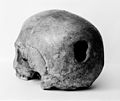Cranial drill
Cranial Drill
A Cranial Drill is a surgical instrument used in neurosurgery for drilling the skull. It is used to access the brain during surgery or to create a burr hole for the insertion of a neurosurgical shunt or an intracranial pressure monitor.
History[edit]
The use of cranial drills dates back to ancient times, with evidence of trepanation, the practice of drilling holes in the skull, found in prehistoric human remains. Modern cranial drills are designed to minimize the risk of penetrating the dura mater and damaging the brain.
Design and Function[edit]
Cranial drills are typically made of stainless steel or other high-strength materials. They are designed to drill through the skull without penetrating the dura mater, the tough outermost membrane of the brain. Some cranial drills have a safety feature that stops the drill from advancing once it has penetrated the skull, reducing the risk of injury to the brain.
Use in Neurosurgery[edit]
In neurosurgery, a cranial drill is used to create a hole in the skull, known as a burr hole, through which surgical instruments can be inserted. Burr holes are used in a variety of procedures, including craniotomy, craniectomy, and the insertion of shunts or intracranial pressure monitors.
Risks and Complications[edit]
As with any surgical procedure, the use of a cranial drill carries some risks. These include infection, bleeding, and damage to the brain or other structures. The risk of complications can be minimized by using a drill with a safety feature that stops the drill from advancing once it has penetrated the skull.
See Also[edit]
Ad. Transform your life with W8MD's Budget GLP-1 injections from $75


W8MD offers a medical weight loss program to lose weight in Philadelphia. Our physician-supervised medical weight loss provides:
- Weight loss injections in NYC (generic and brand names):
- Zepbound / Mounjaro, Wegovy / Ozempic, Saxenda
- Most insurances accepted or discounted self-pay rates. We will obtain insurance prior authorizations if needed.
- Generic GLP1 weight loss injections from $75 for the starting dose.
- Also offer prescription weight loss medications including Phentermine, Qsymia, Diethylpropion, Contrave etc.
NYC weight loss doctor appointmentsNYC weight loss doctor appointments
Start your NYC weight loss journey today at our NYC medical weight loss and Philadelphia medical weight loss clinics.
- Call 718-946-5500 to lose weight in NYC or for medical weight loss in Philadelphia 215-676-2334.
- Tags:NYC medical weight loss, Philadelphia lose weight Zepbound NYC, Budget GLP1 weight loss injections, Wegovy Philadelphia, Wegovy NYC, Philadelphia medical weight loss, Brookly weight loss and Wegovy NYC
|
WikiMD's Wellness Encyclopedia |
| Let Food Be Thy Medicine Medicine Thy Food - Hippocrates |
Medical Disclaimer: WikiMD is not a substitute for professional medical advice. The information on WikiMD is provided as an information resource only, may be incorrect, outdated or misleading, and is not to be used or relied on for any diagnostic or treatment purposes. Please consult your health care provider before making any healthcare decisions or for guidance about a specific medical condition. WikiMD expressly disclaims responsibility, and shall have no liability, for any damages, loss, injury, or liability whatsoever suffered as a result of your reliance on the information contained in this site. By visiting this site you agree to the foregoing terms and conditions, which may from time to time be changed or supplemented by WikiMD. If you do not agree to the foregoing terms and conditions, you should not enter or use this site. See full disclaimer.
Credits:Most images are courtesy of Wikimedia commons, and templates, categories Wikipedia, licensed under CC BY SA or similar.
Translate this page: - East Asian
中文,
日本,
한국어,
South Asian
हिन्दी,
தமிழ்,
తెలుగు,
Urdu,
ಕನ್ನಡ,
Southeast Asian
Indonesian,
Vietnamese,
Thai,
မြန်မာဘာသာ,
বাংলা
European
español,
Deutsch,
français,
Greek,
português do Brasil,
polski,
română,
русский,
Nederlands,
norsk,
svenska,
suomi,
Italian
Middle Eastern & African
عربى,
Turkish,
Persian,
Hebrew,
Afrikaans,
isiZulu,
Kiswahili,
Other
Bulgarian,
Hungarian,
Czech,
Swedish,
മലയാളം,
मराठी,
ਪੰਜਾਬੀ,
ગુજરાતી,
Portuguese,
Ukrainian













